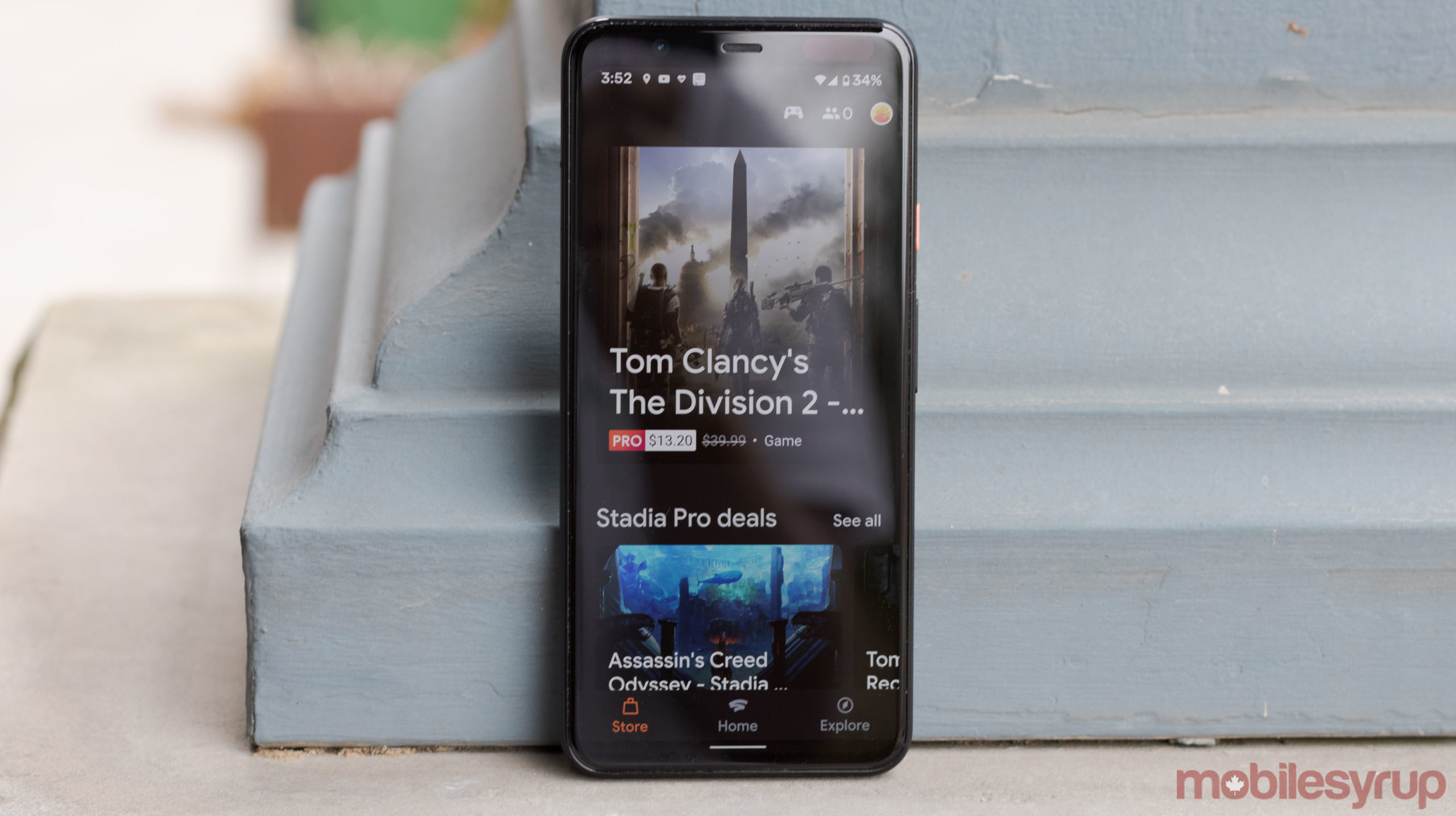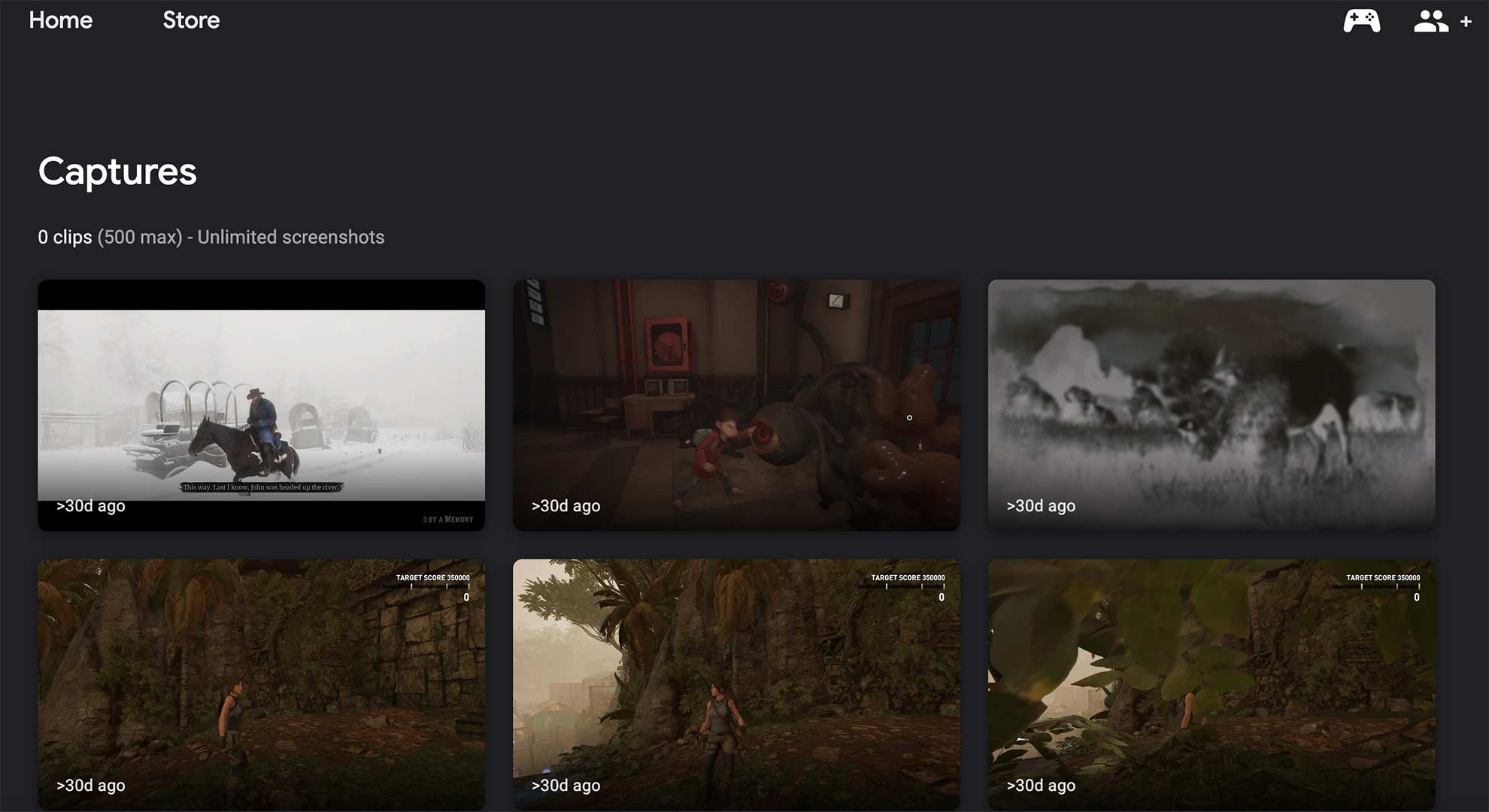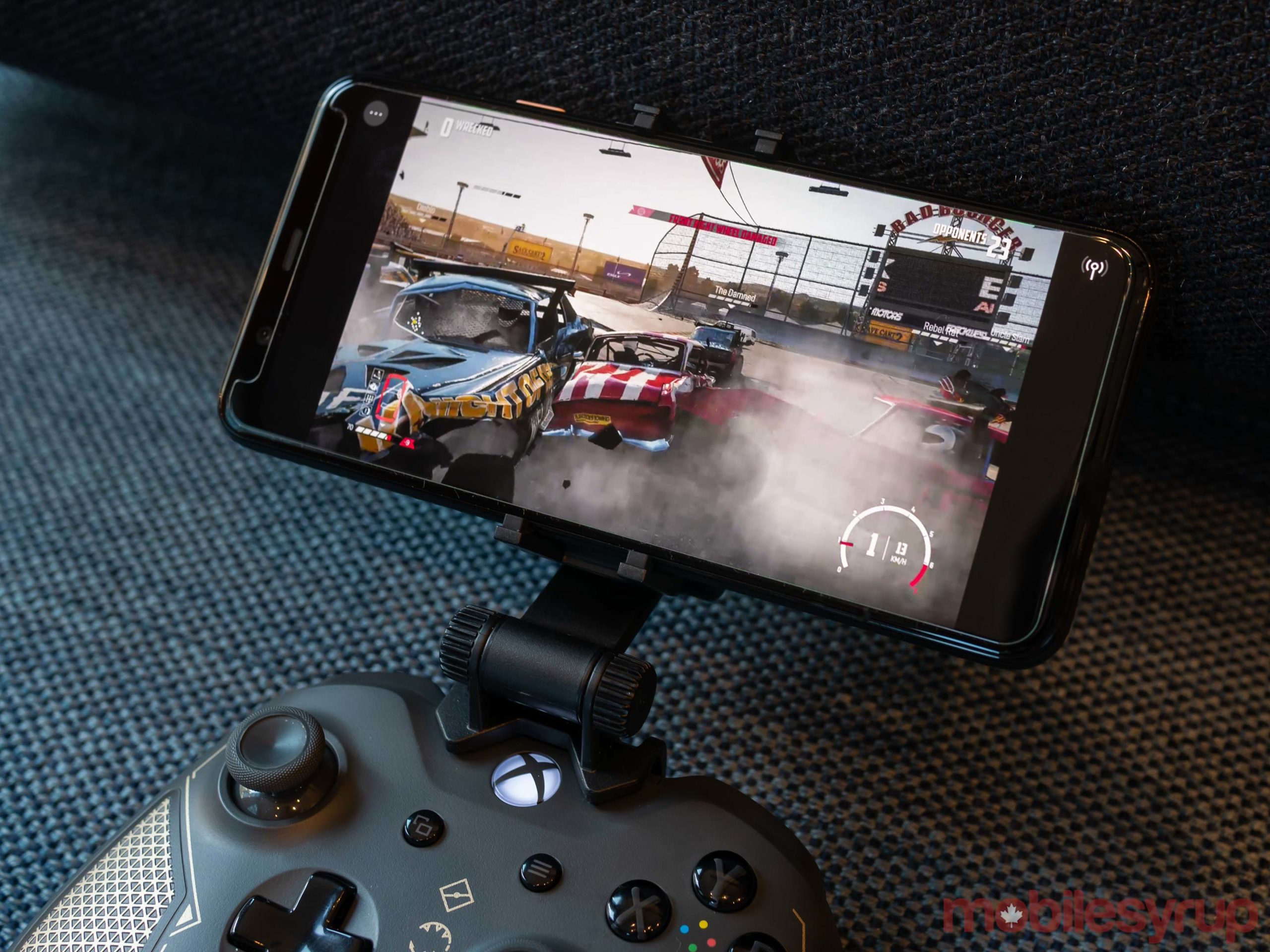
When I reviewed Google Stadia in November 2019, I came away impressed with the streaming technology itself, but disappointed with the lack of games and features present at launch.
With Stadia hitting three months on the market this week, I wanted to take a look back at what Google has done with the service so far. In doing so, however, it becomes apparent just how much more work needs to be done with the streaming platform.
The good
In the interest of being fair, it certainly isn’t all bad with Stadia. As mentioned above, the actual act of streaming works well. Your mileage may vary, of course, but in my own experience, I’ve had rock-solid streams even at relatively lower connection speeds, such as on the public Wi-Fi at Toronto’s Pearson Airport.
Further, Google has done well in supporting a variety of devices. While Stadia (somewhat understandably) only ran on Pixel phones at launch, Google added support for additional Android phones from the likes of Samsung, Razer and Asus. This is in addition to existing support for TVs (via Chromecast Ultra) and the web (which recently received 4K support).
Beyond that, Google has made some significant investments into Stadia game development.
Before Google even launched the service, the company founded its first-ever Stadia Games and Entertainment in Montreal, which will focus on making exclusive games for Stadia. In December, Google acquired Montreal-based Typhoon Studios, which will, no doubt, produce exclusive titles for Stadia now that its first game — Journey to the Savage Planet — has been released.
Google’s Stadia studio in Playa Vista, California
Most recently, Google opened its second Stadia Games and Entertainment studio in early March — this time in Playa Vista, California. The team will be headed up by former Sony Santa Monica studio boss Shannon Studstill (best known for PlayStation’s God of War franchise) and focus on exclusive games.
Studstill — fresh off shipping 2018’s multi-Game of the Year winning God of War — is the latest in a lineup of talented veterans that Google has brought over to Stadia. Others include Stadia chief Phil Harrison (a former vice president at PlayStation and Xbox), Stadia Games and Entertainment boss Jade Raymond (the Montreal producer of Assassin’s Creed) and Stadia Games and Entertainment Montreal head Sébastien Puel (long-running Assassin’s Creed producer). These leaders, alongside the development talent pools in Montreal and California, are a great asset to Stadia going forward.
The problem, though, is that much of everything I’ve mentioned so far is about Google making a long-term promise about Stadia. Unfortunately, Stadia leaves much to be desired when it comes to where it is now.
The bad
To start, Stadia has been lambasted for having a paltry number of games and features. At launch, Stadia had 22 games from various third-party publishers, with one title — indie horror game Gylt — being exclusive.
In the three months since, Google has only slowly trickled out just over a dozen new games to the service’s catalogue, including The Division 2, Borderlands 3, Darksiders Genesis, Tom Clancy’s Ghost Recon Breakpoint and the Serious Sam Collection. Compounding the drip of new content is that virtually none of these games have launched day-and-date on Stadia and other platforms.
One way to improve this is by offering Stadia-exclusive content, but efforts in this regard have fallen short so far. For example, Final Fantasy XV came to Stadia at launch, just under three years after the game originally debuted on consoles. As a bonus, publisher Square Enix threw in some new, Stadia-exclusive minigames, but these were ridiculed for being quite bland and janky.
noctis r u ok#FinalFantasyXV #crazychallenges #Stadia pic.twitter.com/iBmz2ms81m
— Noah Sanchez 💎 (@notesbynoah) March 8, 2020
The one major game that is launching on Stadia alongside other platforms is Doom Eternal, which is coming out on March 20th. The game is already getting rave reviews, making it a fine addition to Stadia’s lineup. Unfortunately, Doom Eternal on Stadia also inadvertently serves to highlight the service’s ongoing problems surrounding game resolution.
As recently confirmed by publisher Bethesda, Doom Eternal doesn’t actually output in native 4K on Stadia, contrary to what developer id Software stated at the Stadia reveal event last March. This follows revelations shortly after Stadia launched that several games aren’t hitting true 4K like Phil Harrison had promised.
In fact, key Stadia games, such as Red Dead Redemption 2 and Destiny 2, don’t actually support 4K. Others, meanwhile, are like Doom Eternal and output at a lower resolution than their native 4K counterparts on PC. A main selling point of Stadia is its ability to stream in 4K/60fps, making this a fairly significant problem for the service overall.

Another way to differentiate games on Stadia is through the platform’s unique features, but these were similarly largely missing at launch and have only come sporadically since. For example, game captures finally made their way to Stadia earlier this month, in addition to the aforementioned 4K on the web.
However, several features that have been promised since before launch — YouTube, family sharing, iOS support and wireless play with the Stadia controller — are still unavailable. Further, three months later and there is still no indication as to when they may be coming.
The ugly
All those other gripes aside, the simple fact of the matter is that Stadia still isn’t easy to try out before buying.
In the months leading up to Stadia’s launch, Google promised a ‘Base’ tier would be available to offer a more accessible way to get into the platform. Currently, the only way to play Stadia is through an $11.99 CAD/month Stadia Pro subscription. While this offers a select number of games for free, like Destiny 2: The Collection and Metro Exodus, the majority of titles still need to be purchased separately.
However, there is no way for general consumers to try Stadia for free. Short of signing up yourself, the only ways to access Stadia are to take either of the following routes:
- Have a friend who bought a ‘Founder’s Edition’ bundle at launch and gifted you a ‘Buddy Pass’ for a free three-month trial, or have bought a Chromecast Ultra, signed up for a mailing list and received a free three-month Stadia Pro subscription
In either case, some prior purchase from either you or a friend is required. The ‘Base’ tier is intended to eliminate that subscription fee barrier, but there’s still no word on when it’s coming, outside of a vague “next few months” window that was given in February.
Further, Base still requires you to buy games á la carte. Therefore, regardless of method, you need to pay for Stadia to try it — there is no truly free option of previewing it before buying. Google’s restrictive approach to accessing Stadia has looked even worse in over the past few months as Microsoft has expanded previews of its Project xCloud game streaming service.

In addition to xCloud simply having far more titles than Stadia to begin with, Microsoft has smartly offered the preview for free to those who register on both Android and iOS. Of course, not everyone who signs up will actually receive an invite, but it’s still a much more accessible and consumer-friendly option. With game streaming very much still in its infancy, Google needs to offer an easier way for people to experience Stadia firsthand.
Stadia’s growing pains are further exacerbated by fledgling developer support. While the aforementioned lack of games is a problem, it’s one that can, in theory, be remedied over time. But the larger issue here is that it’s unclear when (or even if) games are coming to Stadia in the long-term. To be sure, Google’s investments on the first-party front are promising, but third-party support leaves reasons to be concerned. In a Business Insider report from the start of the month, several developers said they weren’t supporting Stadia because Google wasn’t offering much reason to do so.
Besides being unsatisfied with the financial incentives, these developers also noted that they’re simply not optimistic that Google will support Stadia in the long haul. “With Google’s history, I don’t even know if they’re working on Stadia in a year,” one developer said, referring to Google’s tendency to drop products that don’t pan out, like Glass, Allo and Clips. “That wouldn’t be something crazy that Google does. It’s within their track record,” said the developer.
Of course, these developers don’t speak for all game makers, but their concerns do echo a larger apprehension towards Google sticking with Stadia for long. In this regard, Google hasn’t done much to reassure fans, either, having gone mostly radio silent over the past few months. This led Stadia users to express frustration over the lack of communication. It’s not enough for Google to vaguely say that 120 games are coming to Stadia this year and that “more than 10” will be exclusive at launch. A more concrete roadmap of when games and features are coming could go a long way towards putting consumers’ fears to rest.
It also doesn’t help when Andrey Doronichev, the head of Stadia gamer experience, basically ignored criticism of the platform in an interview with Engadget last month. “This is great. This is what this all about, right? It’s not just about some marginal improvements, it’s not about a specific feature,” said Doronichev. “It’s about a big, bold statement of where we are going. We’re going there very, very confidently. So judging by the velocity so far, if anything, I’m more confident in our ability to deliver and over-deliver.” At a time when Google should be eating humble pie, Doronichev makes it seem like they’re carrying on with the swagger of a rock star.
All of Stadia’s problems have resulted in seemingly low player bases for Stadia. While Google hasn’t revealed official sales figures, an idea of the platform’s overall user count can be gleaned by individual game statistics.
Let’s check in on Stadia usage with a new Destiny 2 season launch this week.
On Wednesday:
PC: 437,000
PS4: 460,000
Xbox: 328,000
Stadia: 4,460 https://t.co/k6kbPSEce2— Tom Warren (@tomwarren) March 13, 2020
As noted by The Verge senior editor Tom Warren, Stadia’s Destiny 2 player count started quite small in comparison to other platforms and has continued to drop precipitously over time.
To be sure, not every Stadia user will be playing Destiny 2. That said, it’s a marquee title and the first game included for free as part of Stadia Pro, so it stands to reason that many Stadia subscribers would be playing the game. In any case, it’s not a good sign to see so few people in Destiny 2 on the platform.
Where does Stadia go from here?
That’s very much still up in the air.
Ultimately, while Stadia’s core technology works rather well and Google has taken some solid steps on the first-party development front, the company has much to improve on with the service. Given Google’s general lack of communication, it’s difficult to say when these changes will come to Stadia.
Further, the landscape of the gaming industry is in a particularly evolving state right now — not just due to the impending launches of the PlayStation 5 and Xbox Series X, but the ongoing coronavirus outbreak that’s disrupting businesses across the globe. Hopefully, we’ll learn more soon.
MobileSyrup may earn a commission from purchases made via our links, which helps fund the journalism we provide free on our website. These links do not influence our editorial content. Support us here.



